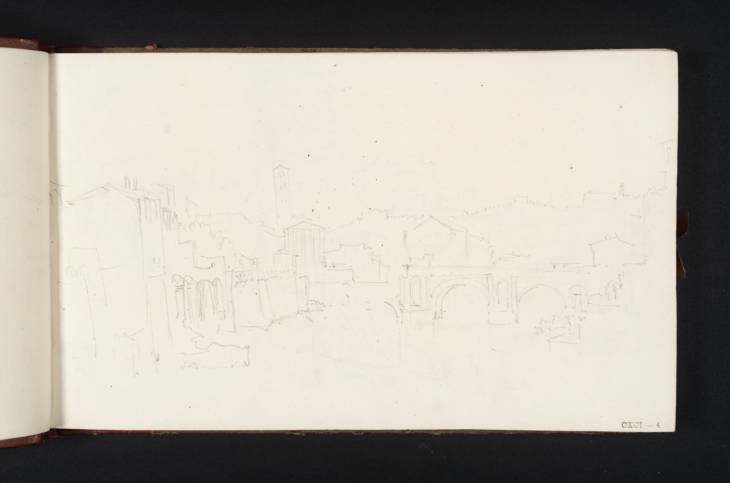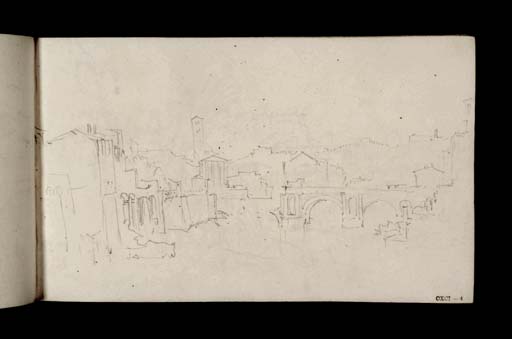Joseph Mallord William Turner Ponte Rotto, Rome, from the Isola Tiberina 1819
Image 1 of 2
Joseph Mallord William Turner,
Ponte Rotto, Rome, from the Isola Tiberina
1819
Joseph Mallord William Turner 1775–1851
Folio 4 Recto:
Ponte Rotto, Rome, from the Isola Tiberina 1819
D16490
Turner Bequest CXCI 4
Turner Bequest CXCI 4
Pencil on white wove paper, 113 x 189 mm
Stamped in black ‘CXCI 4’ bottom right
Accepted by the nation as part of the Turner Bequest 1856
References
1909
A.J. Finberg, A Complete Inventory of the Drawings of the Turner Bequest, London 1909, vol.I, p.567, as ‘Ponte Rotto, with the Temple of the Sun, &c., beyond’.
This sketch appears to have been drawn from the Isola Tiberina looking downstream to the Ponte Rotto (formerly the Pons Aemilius), an ancient ruined stone bridge at the southernmost tip of the island. The structure was originally damaged by a flood in 1598 which swept away the eastern pillars, hence its name which literally translates as ‘Broken Bridge’.1 Today there is just one isolated arch remaining as a freestanding structure in the centre of the river near the late nineteenth-century iron bridge, the Ponte Palatino. However, in Turner’s day there were three full arches still in existence, linking the bridge to the Trastevere district on the right bank. Many of the houses and mills lining the river were demolished during the construction of the Lungotevere and embankment at the end of the nineteenth century. To the left of the bridge can be seen some of the buildings and monuments of the Forum Boarium, including the circular Temple of Hercules Victor (sometimes called the Temple of Vesta or Temple of the Sun) and the campanile of the Church of Santa Maria in Cosmedin.
Views of the Ponte Rotto were a popular subject within the tradition of Italian vedute and hence had become part of an established repertory of views for English tourists to Rome.2 Turner’s view is very similar to one drawn by James Hakewill in 1817, Rome. View from the Convent of S. Bartolomeo Looking to the Ponte Rotto, the Temple of Vesta etc., (British School at Rome Library).3 Compare also the painting by Penry Williams (1802–1885), The Tiber with the Temple of Vesta, Santa Maria in Cosmedin and the Ponte Rotto seen from the Convent of San Bartolomeo 1828 (National Museum Wales). For other sketches by Turner of the Ponte Rotto see the Albano, Nemi, Rome sketchbook (Tate D15376; Turner Bequest CLXXXII 43) and the St Peter’s sketchbook (Tate D16249–D16250; Turner Bequest CLXXXVIII 52–52a). A related composition can also be found in the Small Roman Colour Studies sketchbook (see Tate D16450; Turner Bequest CXC 37).
Nicola Moorby
February 2009
Raymond Keaveney, Views of Rome from the Thomas Ashby Collection in the Vatican Library, exhibition catalogue, Smithsonian Institution, Washington 1988, p.90.
For example Gaspar van Wittel (Vanvitelli, 1652/3–1736), Il Tevere e il ponte Rotto dall’Aventino, 1682 and Giuseppe Vasi (1710–1782), Ponte Rotto 1754, see http://vasi.uoregon.edu/vedutismo.html , accessed June 2009.
How to cite
Nicola Moorby, ‘Ponte Rotto, Rome, from the Isola Tiberina 1819 by Joseph Mallord William Turner’, catalogue entry, February 2009, in David Blayney Brown (ed.), J.M.W. Turner: Sketchbooks, Drawings and Watercolours, Tate Research Publication, December 2012, https://www


